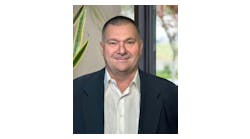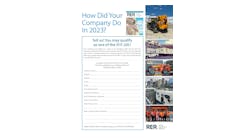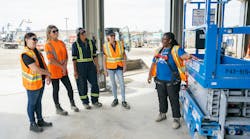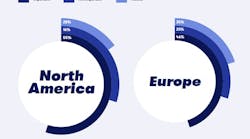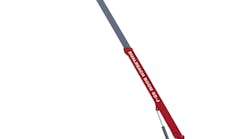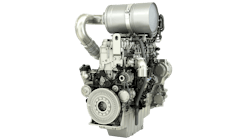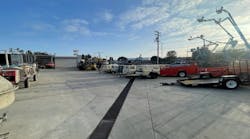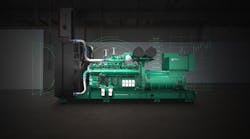Awareness of safety on mobile elevating work platforms has increased significantly in recent years. The activities and consciousness raising of organizations such as the International Powered Access Federation have played a significant role. Rental companies have also become far more diligent in train-the-trainer programs and making sure customers are properly trained and familiarized before operating MEWPs.
Manufacturers have played a significant role as well by developing training programs as well as installing safeguards on the equipment they design and build to make them safer. This article looks at several legacy aerial equipment manufacturers to see the improvements they have made on their equipment from the training and safety standpoints, and the other programs they offer.
JLG Industries
Bill Dovey, senior product manager boom lifts, starts with the company’s manufacturing process:
JLG has numerous procedures and instructions in place to ensure that everything we build is built and tested to meet and exceed all applicable regulations, ANSI standards, and federal regulations. That’s something we are required to do, but we strive to exceed what’s required.
All of our control panels, from the E300 to the 1850, are similar in layout. When you get training on one boom lift, you’re going to be at least familiar with the controls on the rest of our product line because they are all laid out the same, making them intuitive for the operator. That’s something we’ve been doing for years. And we have our exclusive SkyGuard enhanced control panel protection system standard on nearly all JLG boom lifts. It not only stops functions when you put a force of 50 pounds or more against it, but it also temporarily reverses the functions in use at the time to undo what caused that bar to get pressed.
Also on things like slowing the lift function down right before you top out at full elevation so you don’t get a sudden stop or an uncomfortable jolt at the top make for more comfortable operation. We call it end-of-stroke cylinder dampening. Recently, with new products introduced, starting with the 400 S and the 450 AJ in 2014, we have increased platform capacity to aid productivity.”
Rick Smith, senior director of global product training, weighs in on new training requirements:
It’s excellent that the industry is supporting more stringent training of our operators; service personnel too. Techs being fully trained to service machines properly are becoming more of a focus. Another focus is multi-lingual training materials, and obviously operation manuals, which we’ve done for years. Trying to make sure that the materials we put out are available in the language of the user. That’s been a significant focus of ours for the last couple of years. We have hundreds of videos out there in multiple languages, and we’re translating our training materials in the U.S. into Spanish and worldwide into multiple languages.
We’re using virtual reality more and more. We’ve added remote instructor capability. It allows us to conduct virtual instruction, meaning I can have 20 different people in the virtual reality with me and can bring them into the platform alongside me. So we can do virtual demos. I can be in the platform with you while you’re in a different city and I’m here. You can be operating the virtual machine while I’m standing right next to you. We can talk to each other and I can instruct you in a particular situation. Remote instruction and VR as a whole is becoming more affordable and I think it’s going to become quite mainstream. We’re making improvements to it all the time. We have some machines placed with our customers around the country, and they are using it right now and providing us awesome feedback.
Students really like it, it makes safety training fun, which is hard to do. Folks line up to get in it and enjoy it. You see a significant reduction in the hands-on practice time required once they’re in the actual machine to do their evaluation; it reduces that time significantly because they become familiar with the machine.
RER: It seems to reduce intimidation and fear before they get into a real MEWP.
Smith: It does. They know that this control will make it go up and this will make it go down and how the footswitch works… Just last week we were at an event, and a lot of the folks used our drive orientation override, which means you’ve swung the boom past the rear axles so you need to hit that switch to remind the operator that they need to beware that the machine may move in the direction they don’t intend for it to move. If you’ve swung 180 degrees and you’re going to move the machine forward, what you think is forward is actually reverse. So, the driver orientation override actually is something that the operator needs to practice using, and we did that a lot in VR. When they jump in the real machine they know exactly why the machine won’t move. It prevents the machine from moving until they acknowledge that they’ve turned past the axles.
Our train-the-trainer program continues to get great reviews. And the reason people love the program is they spend 70 percent of their time operating machines, so the trainers become very confident in their ability, which is transmitted into the classroom. All of our operator materials have been updated and they are ready for the new ANSI standards. One example, our compact crawler booms, what’s called atrium lifts in the industry, is now in a class of its own, at least in our case. In the new classification, it’s a 1B machine which means it’s a boom lift that can’t be driven from height because the outriggers have to be down. The industry is going to have to qualify all the operators of those types of booms as 1B operators in the future, so we’ve got all our training materials ready to go for the 1B operators.
We are lining all our materials up to the new classifications and the new standard requirements. All that work is done; we’re just waiting for the ANSI standards to be published.
One of the new requirements is supervisor training which is a new program for the industry. IPAF has had one for a while, but we have one now also that will be ready by the time the new standards roll out so we’ll be ready to help our customers in the industry with those training requirements. I think that’s a great addition. Anybody supervising MEWP operators will have to be trained as a MEWP supervisor. That’s new and I think it has a direct bearing on safety in the industry. The supervisor’s focus will be on understanding the new standards and selecting the proper MEWP as well as site risk assessments, which is a new requirement.
JLG has added a new option to its high capacity telehandlers called SmartLoad Technology which will aid safe operation. SmartLoad is an advanced bundle of three integrated technologies that work together to deliver a greater level of operator confidence. The first component of the SmartLoad Technology bundle, attachment recognition, allows a telehandler to identify an attachment and display the appropriate load chart to the operator. The second, a load management information system (LMIS), graphically depicts the location of the load within the load chart, provides the operator with an indication of compliance, and prevents the operator from violating boundaries of the chart. The third technology, a load stability indicator (LSI), works in conjunction with the LMIS to limit operation when a load is nearing the maximum capacity indicated on the load chart.
@@@@@@@@@@@@@@@@@@@@@@@@@@@@@@@
HAULOTTE
Maxime Girard, product manager - Americas
The new ANSI standards will mean safer machines for the whole industry with new systems such as load sensing, which will restrict boom movements in case of machine overload. When it comes to safety, everybody is concerned: employees, employers, manufacturers, rental companies, and contractors. Selected manufacturers, such as Haulotte, go even one step further regarding safety.
Operator Safety
Operators at heights face many dangers, particularly crushing risks. To prevent these risks and protect operators, Haulotte has developed the ACTIV’Shield Bar 2.0. Note that this secondary guarding system is now fully integrated into the upper control protection cover to guarantee better ergonomics and enhanced robustness. Thanks to the pivoting safety bar, which provides a “safety gap”, workers are protected from any risk of crushing without compromising productivity. This system comes standard on all PRO premium models.
Transport
The operators are not the only workers using MEWPs. Rental companies also have to consider the transportation of the equipment. Each year, there are millions of equipment deliveries. Truck drivers are on the front line, loading and unloading machines under every weather condition: rain, snow, hot, cold, or at night. Haulotte strives to provide the industry and equipment users safety features that really matter. To increase the productivity of the transport phase while improving drivers’ safety at work, Haulotte offers an ultra-high-performance lighting system called the Haulotte Activ’Lighting System-Safe Load on all its new booms. Equipped with a light sensor, the system automatically turns the lights on to illuminate the controls and the area around the machine allowing truck drivers to safely load and unload equipment at dawn or dusk.
Troubleshooting
In case of a problem or malfunction, it is always more advantageous to have easy and instant access to the information necessary to intervene or exchange remotely with a technician. Haulotte has implemented the Haulotte Activ’Screen, an onboard diagnostic system, on its full line of products. The Activ’Screen acts as a veritable assistant, supporting users daily in carrying out maintenance operations. It gives the operator access to key real-time information on the function and status of the machine.
The Activ’Screen provides key information for users and technicians including alarm display, diagnosis of malfunctions, machine settings, maintenance alerts, and modifications of general settings such as interface language and units of measurement. This also helps keep downtime to a minimum.
Environmental Safety
Across the industry, MEWP manufacturers have worked diligently with engine suppliers to be compliant with new environmental regulations without affecting our business too much. Currently, there is no need for a diesel particle filter to comply with the emission level imposed by the regulation.
Rental companies can benefit from new innovative systems recently launched in the industry by some manufacturers such as Haulotte, which has pioneered a market leading engine technology in diesel booms called the “Haulotte Stop Emission System.” This is a simple innovation that is known in other industries, but is exclusive to Haulotte in the MEWP market. During normal machine use, the engine often runs unnecessarily, and the Haulotte System automatically shuts it down after 90 seconds of boom inactivation. This results in less noise on the worksite, a more environmentally friendly machine, and most importantly, a 20 percent reduction in engine running time, which ultimately increases the residual value of the equipment and finally, allows the company to reach its main goal: to decrease the total cost of ownership.
Safety Training
Haulotte offers a network of instructors to provide customers with know-how as well as the skills essential for guaranteeing safety, expertise and effectiveness when maintaining and operating Haulotte equipment. The Haulotte Services training catalogue is entirely adapted to providing customized instruction tailored to each individual need. Theoretical and practical training sessions are conducted at our North American headquarters in Virginia Beach, Va., to ensure professional training and practical understanding of material.
@@@@@@@@@@@@@@@@@@@@
Genie
Answers provided by Marie Engstrom, Genie Product Manager, Terex AWP
RER: What is Genie doing in manufacturing to make equipment safer?
Engstrom: Genie aerial equipment is designed specifically for safe work at height. This is achieved through both active and passive safety features. Active safety features include systems that alert an operator to, and prevent an operator from, using the machine in an unsafe configuration. Passive safety features, like fall restraint (safety lanyard attachments) and fall protection (guard rails), are designed to prevent accidental injury. None of these systems are available to a user of the common ladder. By offering appropriate work-at-height solutions to replace ladders and scaffold in nearly any application, Genie is actively promoting the number one priority on any aerial jobsite, which is providing a safe workplace for both the operators and the equipment.
New Accessories
At Genie, we are always working to improve and evolve our operator protection products. One significant change is the addition of the Genie Lift Guard Contact Alarm system. Booms, telescopic and articulated, are often chosen for their ability to get up and over obstacles and reach out to work areas. This means that overhead obstructions are frequently within reach of operators. To help protect users in these types of environments, Genie launched the Lift Guard Contact Alarm, an electronic secondary guarding system designed to activate when an operator makes contact with an activation cable above the platform control panel, resulting in cutout machine motion. The system also alerts ground personnel that assistance may be needed. A free-movement zone exists between the cable and control box which allows operator mobility after system activation. This is a standard feature on nearly all Genie booms.
We are also seeing increased need from end users on incorporating both direct and indirect visibility aids, such as rear proximity alarms and rear facing cameras into telehandler models. These visibility aids have gained popularity in closed sites where the size of the equipment and volume of mixed traffic necessitate additional precautions. To meet market demand for these types of features, Genie offers a rear proximity alarm, which alerts the operator when an object is in the detection field of the sensor, across its entire telehandler product line. Although this option is a great tool for operators and rental companies alike, it may not be needed on every jobsite. For this reason, Genie offers a Proximity Alarm Ready solution, where the machine is pre-wired for the rear proximity alarm or camera, but the hardware can be purchased separately and quickly installed on a machine as the feature is needed.
Updated Design Standards
The coming years will mean big changes for customers purchasing aerial products in North America as manufacturers and jobsites will need to adhere to the updated ANSI and CSA standards. Updated machine requirements, which include articulated booms, are being finalized within the standards committees, but we can expect required compliance in mid-to-late 2018.
While a lot will change, a few notable items stand out: First, machines will be required to weigh the load in the platform. This is often referred to as “load sense.” Booms often lift multiple users, equipment and supplies to get into tight spaces to do work. In the future, if users exceed the rated load of the machine, some functions will be disabled until the appropriate amount of weight is removed. Expect to see manufacturers of both articulated and telescopic booms enhance machines to allow additional rated load to minimize the frequency of this standards change disrupting productivity. Similarly, when the machine has exceeded the allowable slope, some functions will be disabled under the new requirements. Only necessary functions will be allowed to return the machine to a slope within the allowable range.
Changing requirements for stability testing will require what is effectively a “flat tire” test for machines with air-filled tires. This can be a challenging test to pass for certain machines so expect to see some manufacturers moving to solid tires where machine parameters cannot continue to accommodate air-filled tires. This will vary across the range of booms.
Training Programs
For more than 50 years Genie has provided education, support and solutions that fleet owners, employers and operators depend on to help protect their investment and livelihood. Who better to provide the training than the people who make the lifts?
Whether in-person or online, Genie can help train customers to operate, sell or maintain aerial equipment to its full potential. We offer safety training for operators or instructors, in-depth product training for salespeople and service training for technical personnel; all designed by the people who know the equipment best.
For high-quality functional training at your convenience, we recommend the company’s Pro Suite online classes: Genie Lift Pro for online operator training, available through participating Genie distributors, and Tech Pro for online service training classes, available to order directly from Genie.
Lift Pro Online Operator Training
Safety is always job one on every work site. Most accidents or equipment damage happens when operators overlook important safety precautions or don’t fully understand how to operate equipment. That’s why Genie developed this two-part program, delivering a standardized aerials or telehandler training package, to help operators stay safe and fleet owners reduce their repair costs.
Genie Lift Pro Training
- Designed by the manufacturer for high-quality, simple and standardized delivery
- Meets applicable ANSI, OSHA and CSA requirements
- Is applicable to operators of most aerials or telehandler brands, makes and models
Lift Pro Train-the-Trainer Courses
Genie Lift Pro Train-the-Trainer courses are designed to qualify operators in the safe use of aerial work platforms or telehandlers and then provide additional helpful training techniques and information that can improve their ability to deliver a successful Genie Operator Training Course. After having completed the Train-the Trainer course, the trainee's employer must determine if they are then qualified, as defined by criteria set forth in OSHA and ANSI, to train other trainers or operators.
The course is delivered using curriculum that combines both formal and hands-on training. Each participant will receive a Lift Pro Operator Training Kit upon successful completion of the course.
Tech Pro Online Service Training
Ensure aerial equipment is maintained to the highest standard. Acquire professional training and know-how by accessing Genie Tech Pro classes online or at one of our world-class training centers.
Online Training
- No minimum class size / low impact on staffing
- Less service “down time” for training
- No travel expense or “group” time loss
- Technicians can work at their own pace
- Available 24/7/365 to access from work, home or any computer
- Compatible with multiple web browsers
- Course completion status is recorded for reporting
- A certificate of training is available for each course upon completion
The Genie Lift Pro Operator Training and Genie Tech Pro Service Training sites have been updated to include information and training on important changes in the pending ANSI A92 (United States) and approved CSA B354 (Canada) standards in North America, including safe-use planning and new training requirements for supervisors and occupants, as well as maintenance and repair personnel.
Genie Aerial Pros
Genie Aerial Pros is dedicated to educating the aerial industry on important subjects, such as upcoming changes to ANSI and CSA standards, safety and training, service, product introductions and new applications. The website also gives customers’ insights on sales and marketing best practices, company news, as well as upcoming industry and company events. Content featured on Genie Aerial Pros includes tips and trends articles, product bulletins and videos, industry alerts, customer success stories, testimonials and more.
@@@@@@@@@@@@@@@@@@@@@@
Snorkel
Responses by Matthew Elvin, CEO, Snorkel
At Snorkel, we take safety seriously. Ultimately, aerial lifts are designed to make working at height both safer and more productive than traditional methods, including ladders and scaffolding towers.
However, as a manufacturer, we are always looking for new ways to improve our product designs to minimize risk to the operator, without impacting productivity or serviceability.
One of the major changes that we implemented in recent years was the introduction of Snorkel Guard, our secondary guarding solution for boom lifts. Designed by Snorkel’s in-house engineering team, this low maintenance, mechanical system offers additional protection for the operator, without adding any complexity to the lift.
Simple and effective, Snorkel Guard features a spring-loaded rail mounted above the upper controls. When the rail is compressed, the machine operation will cut out. If the operator is able, they can re-activate the lift using an override switch in the platform. Alternatively, the lift can be operated using the ground controls.
Snorkel Guard was introduced in September 2015, and is fitted as standard to all new build Snorkel articulated and telescopic boom lifts. We were one of the first manufacturers to equip all products with a secondary guarding solution as standard. Snorkel also offers Snorkel Guard as a quick-install retrofit option for existing Snorkel lifts in the field.
In our latest product developments, we are also introducing new features that bring additional safety benefits. On the new line of Snorkel mid-size telescopic boom lifts, we have designed the platform to be easy to swap out, using just six bolts. This means that if a platform is damaged in the field, the rental company can quickly and easily remove the platform from service, and replace it.
Additionally, our new telescopic boom lifts have enhanced static steering, which only unlocks the front brakes when turning at rest. This means that the rear brakes remain locked on, holding the machine steady on an incline. The new Snorkel telescopic boom lifts also have full proportionality on all functions, along with a proportional throttle to ensure all function operation is smooth and controlled. This helps to give the operator greater confidence when using the lift, particularly when working in confined spaces, and reduces the risk of a collision.
We have applied the same thought process to our scissor lifts and mast lifts products as well. All of the lifts in these families feature saloon-door style entry gates for improved entry and egress to the platform, particularly when carrying tools or materials. We have also incorporated handholds onto our latest models of electric slab scissor lifts and telescopic mast lifts for the extension deck operation. These handholds enable comfortable operation of the extension deck, with hands moved away from the rails themselves, avoiding the risk of pinch points.
@@@@@@@@@@@@@@@@@@@@@@
Skyjack
Ian McGregor, director of product safety
Existing Initiatives
Skyjack has always taken a “safety first” approach to how we do business. The company is fully involved in the development of industry standards and is active within trade associations that promote the safe use of our products. With a president whose background was product safety management, it is no surprise that focus remains. Whether it be the adoption of IPAF (International Powered Access Federation) training practices and being a key supporter of their introduction to North America, a leader in the campaign for harness use on booms, or the introduction of secondary guarding on booms, safe use of equipment is high on Skyjack’s agenda.
Items in the works:
ANSI Standard
With the impending implementation of new ANSI 92.20 design standards, we’ve taken the opportunity to thoroughly look at our products and see how we can not only comply, but simplify as well. To comply with new standards’ requirements, most MEWPs (mobile elevating work platforms) will utilize an active load sensing system to prevent certain misuse on mobile elevating work platforms. On Skyjack scissor lifts, that means a combination of scissor stack angle sensors and pressure transducers, and on Skyjack booms it means the installation of load cells to measure platform loads and disable regular functions if overloaded. Skyjack booms will be equipped with electrical secondary guarding (SGE) as a standard feature.
Skyjack’s SGE system features a sensor bar that instantly stops all functions when pushed against and initiates an audible siren and light beacon. If pressure is applied to the bar for more than one second the engine will also stop, which halts all regular functions until reset. The emergency lowering controls can still be operated to bring the platform safely to the ground. Skyjack scissors will be equipped with a durable and easy to maintain high-quality composite box with a shroud-style guard integrated into the design.
Telematics
Skyjack recently launched its fully customized off-highway telematics solution, Elevate, powered by Trackunit, at The Rental Show in New Orleans. In addition to providing rental companies with oversight on utilization, fuel consumption rates, and battery pack management, it also provides additional safety benefits.
Contributing to paperless pre-checks, and ensuring operators are accountable for their daily duties, the two mobile-first apps, Elevate ON and Elevate GO, will revolutionize the way safety is seen onsite. These apps can also provide the operator with familiarization materials at their fingertips, enhancing the delivery of essential operator information prior to use.
Elevate is a tech-based solution that can not only create more efficient processes on-site, but also improve safety conditions as well.
PPA (Platform Proximity Alert)
Skyjack has developed a concept of a sensor system, which is designed to reduce the potential for collision and unexpected interference from overhead obstructions. Our PPA uses ultrasonic wave detection, which allows the system to check for objects above the platform when raising, without interfering with the physical working space of the operator.
A model of this system was displayed on an SJIII 4740 at The Rental Show last month. Still in the concept stage, but once finalized, this will be an additional method of reducing the potential for entrapment.
Electric E-Lowering
We’ve redesigned our DC electric scissor emergency lowering system to be operated from a single location, simplifying operation.
Whitepaper and social media initiative
Skyjack published a whitepaper outlining its traditional safety and maintenance education initiatives, such as service bulletins, service advisories, and tech tips. In addition to these traditional routes of getting safety and maintenance information to customers and end users, Skyjack has also taken this initiative online through digital media efforts. Skyjack has begun commenting and providing insight whenever we see potential misuse depicted in images of our products. These comments typically direct the audience to Skyjack’s safety precautions page, which acts as a quick reference tool to remind and educate users of the correct use of MEWPs.
Safety Training
Skyjack offers a variety of training options for all products that we manufacture, including IPAF eLearning for MEWP operator training. All operating, service, and parts manuals are readily available for download online on our website.
In addition to providing guidance in operating manuals for all new products to assist operators in meeting their familiarization requirements, Skyjack has been developing familiarization videos to deliver content that assists with compliance to A92.24 requirements. It is also developing supplementary materials for historical products to help operators meet A92.24 familiarization requirements.
Skyjack is also finding additional ways to innovate the delivery of operator training. Leveraging technology from Serious Labs, and working hand-in-hand with IPAF and United Rentals, Skyjack announced that it has scissor and boom training simulators in development. At The Rental Show, Skyjack had a simulator onsite for attendees to try for themselves. Training via virtual reality has been used for decades with products such as aircraft, and incorporating this technology into the MEWP industry is a logical next step in promoting safe use and operator training for Skyjack.
If you’re looking for more information on Skyjack’s efforts towards increasing safe use on products, more information can be found in its Skyjack Safety Initiatives white paper.
